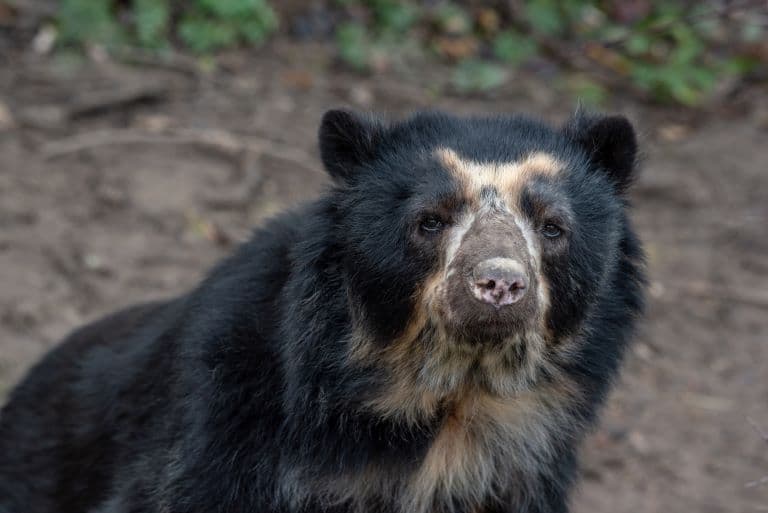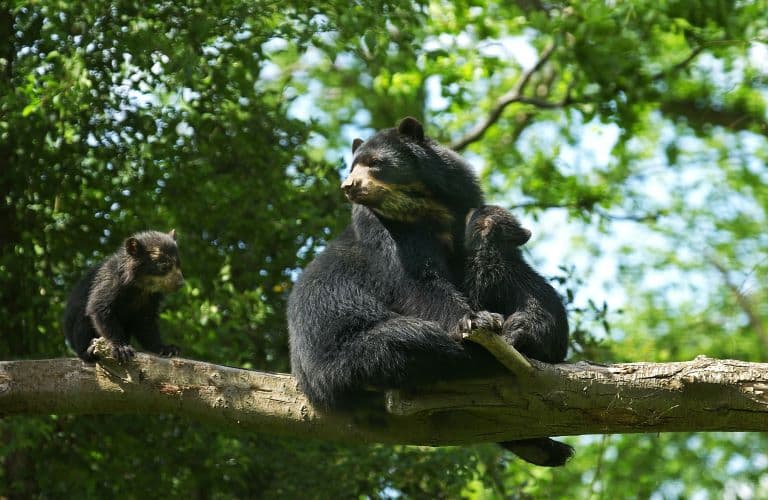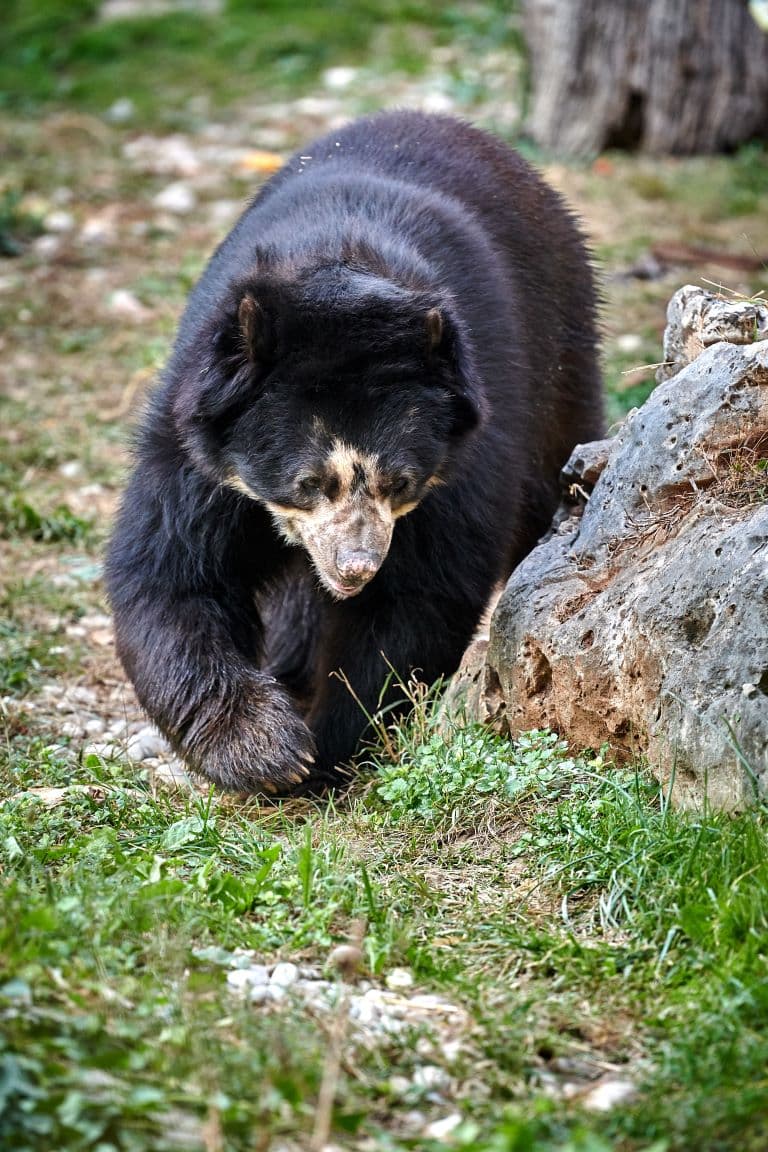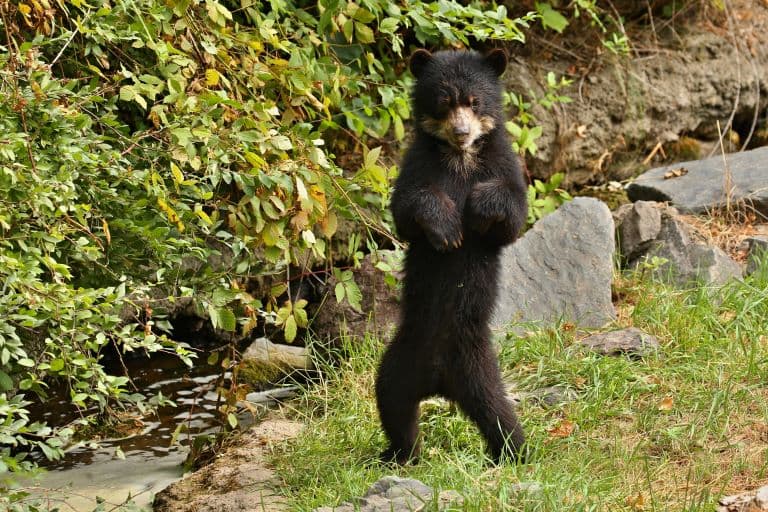Spectacled Bear Profile
When early humans entered the Americas, they were faced with unimaginable terrors.
Despite having waded through Old World giants like the cave hyenas and sabre-toothed tigers for thousands of years, their trials weren’t over. In what is now North America, humans were met with American lions, Dire wolves and short-faced bears, some of which may have reached 1,200 kg in mass and been quite grumpy about the new arrivals.
And while the vast majority of modern bears have no relation to these terrifying animals, one species survived the extinction of the short-faced bear lineage and exists to this day. A smaller reminder of a monstrous history: the Spectacled bear.

Spectacled Bear Facts Overview
| Habitat: | Mountain regions |
| Location: | South America |
| Lifespan: | Likely more than 37 years |
| Size: | Around 2m (79 inches) long, 76cm (30 inches) tall |
| Weight: | 200 kg (440 lb) in males, females much smaller: 82 kg (181 lb) |
| Colour: | Mostly black, with orange to white markings on the face and throat |
| Diet: | Mostly fruit, some animal prey, carrion |
| Predators: | Few: cougars will attack cubs, humans occasionally kill adults |
| Top Speed: | Not reported |
| No. of Species: | 1 |
| Conservation Status: | Vulnerable (IUCN) |
Spectacled bears are named for the yellowish markings on their face, and when compared with their terrifying ancestry, they may be considered the smaller, nerdier cousins.
They’re mostly herbivorous, using an exceptional sense of smell to find trees with fruit in them, which makes up the majority of their diets.
But, being short-faced bears, they do have to kill things occasionally, and when they do, they’re very powerful murderers. This is what brings them into contact with their only legitimate threat: humans.
Interesting Spectacled Bear Facts
1. They’re short-faced bears!
Shor-faced bears would have been the largest carnivorans in the Americas and mostly went extinct by the end of the Pleistocene, but the spectacled bear is likely their only remaining relative.
While other species of modern bears are from the Ursinae subfamily, spectacled bears make up the entirety of the subfamily Tremarctinae, a group once filled with various monsters.
These bears patrolled the Americas looking very mean and while there were once four genera and likely more than 11 species, this little bear from South America is the only one that remains.
How this one survived when its cousins went extinct may have something to do with its diet.

2. They’re herbivorous
The short-faced bears are so-called because of the illusion that their faces are shorter, but this is more of a perspective thing, relating to the width of the nose bone in relation to the length of the skull.
But even this adaptation presents a puzzle. It was once thought that the short-faced bears evolved a wider skull to handle a more carnivorous diet, but the spectacled bear has the same face and almost exclusively eats fruit.
The majority of this bear’s diet comes from cactuses, bromeliads, palm nuts and bamboo. They’ll also strip trees of bark to access the underlying nutritional layer and can eat plant material that’s so fibrous that not much else does.
So, it appears that the wide face of this bear is an adaptation to gnawing on roughage, rather than crunching on bones, and indeed, we see a similar morphology in pandas in this regard. 1
3. They can smell fruit
When observed, these bears eat about 70% of the time. It seems like palms are their fruit of choice, and they will wander around the forest floor using an exceptional sense of smell to identify from the ground, trees that have fruit way up in the canopy.
Their eyesight isn’t the best, but their ability to sniff fruit is hard to beat, and this is coupled with a powerful set of climbing arms and claws that can lug their great mass up there to eat it.

4. They do hunt sometimes
That said, these bears haven’t lost all of their predatory instincts. Around 7% of their diet might come from hunted animals.
These bears are big enough to take down deer, tapirs, llamas and even domestic animals, which has caused them to be considered a bit of a pest to local farmers. 2
5. They sometimes get into trouble
As human presence encroaches on the bears’ habitats with increasing livestock presence, human-wildlife conflict begins to arise.
This species can bring down animals over twice their mass, and while rumours were always going around of this species bringing down horses and cattle, it wasn’t until 1997 that a reliable witness account emerged.
While this does happen, it’s far more likely that the bear will exploit carrion from cattle that have already died, and be blamed for killing them. Regardless, this has led to revenge killings and has contributed to their Vulnerable status. 3
6. In general, they’re pretty chilled out
These bears are solitary animals and prefer to keep to themselves. They avoid competition and are not territorial, and will even be seen feeding in small groups when there’s plenty to go around.
These are adaptable and hardy bears, able to thrive in cloud forests, grasslands and scrub, and happily moving between all three in the pursuit of food.
The exact nature of these migrations is yet to be understood, but they’re known to be comfortable from 475 to 3700 metres above sea level. 4

7. They’re very good at climbing
Their front legs are longer than the back, and despite their stocky and lumbering appearance, they’re excellent at climbing trees.
As such, this species is one of only four bear species considered to be arboreal, spending periods of both day and night in the tree canopy. This has been a saving grace for the species, as it is one of the key ways they avoid the presence of humans as much as possible.
Unfortunately, avoiding humans is becoming more and more difficult.
8. They’re in decline
Agricultural expansion is the major player involved in the decline of this species. Livestock and human development encroach on their habitat and leave them little room to live.
Mining also plays a role as the habitats are destroyed to access resources, and even illegal slaughter of the bears is a significant threat.
Finally, climate change makes all of these challenges worse, with predictions of further habitat reduction and shifting land-use patterns threatening the species even further. 5
Spectacled Bear Fact-File Summary
Scientific Classification
| Kingdom: | Animalia |
| Phylum: | Chordata |
| Class: | Mammalia |
| Order: | Carnivora |
| Family: | Ursidae |
| Genus: | Tremarctos |
| Species: | T. Ornatus |
Fact Sources & References
- Davis, D. Dwight (2007), “Masticatory apparatus in the spectacled bear, tremarctos ornatus”, Internet Archive.
- Armando Castellanos (2005), “Ecología y Comportamiento de Osos Andinos Reintroducidos en la Reserva Biológica Maquipucuna, Ecuador: Implicaciones en Conservación”, Research Gate.
- Alastair Bland (2013), “What Should Be Done With Yachak, the Cattle-Killing Bear of the Andes”, Smithsonian Magazine.
- David D. (1984), “The Encyclopedia of mammals”, Internet Archive.
- “Andean Bear”, IUCN Red List.
